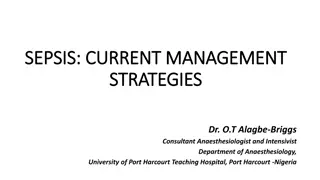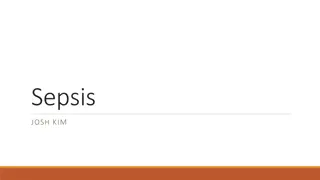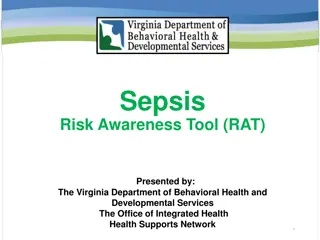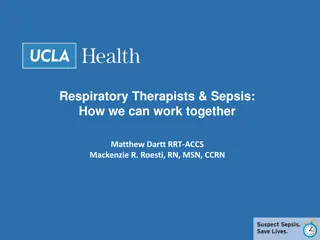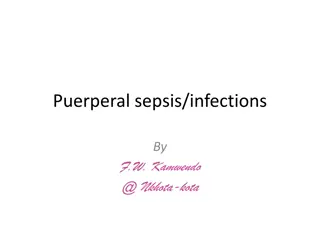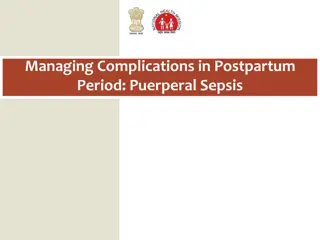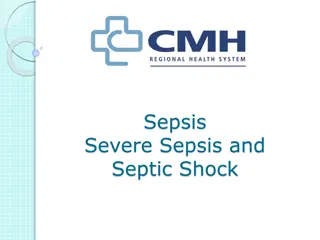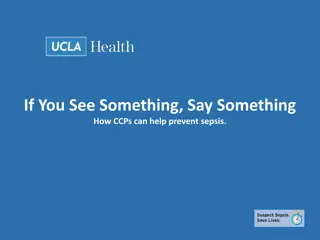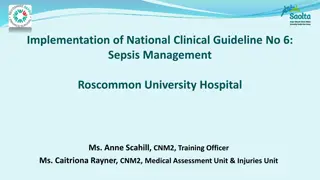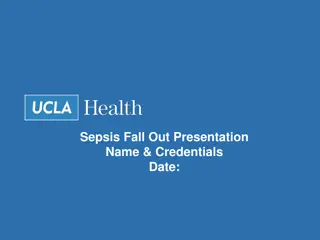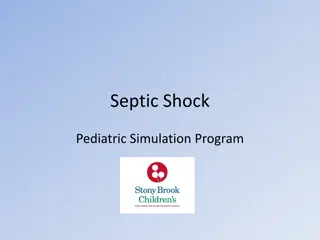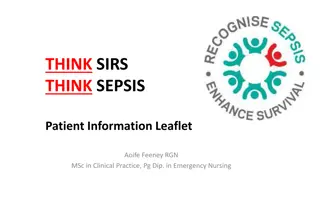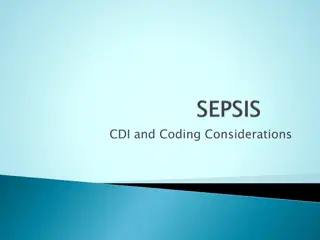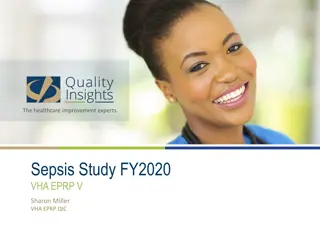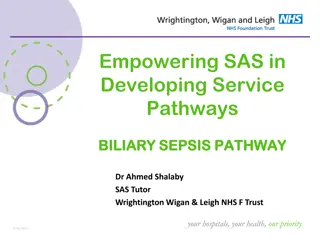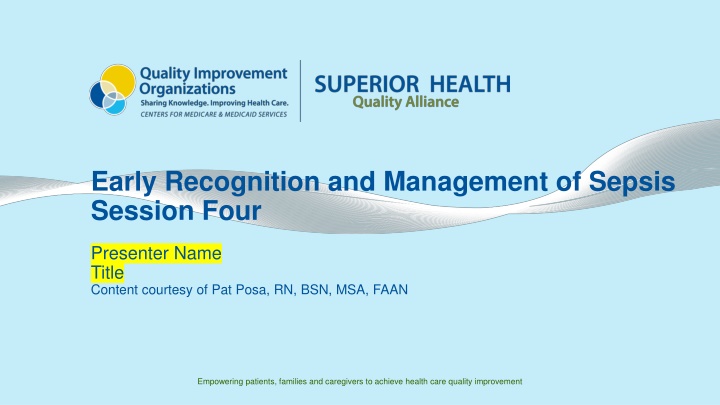
Empowering Patients through Early Recognition and Management of Sepsis Program
Discover how the Early Recognition and Management of Sepsis Program empowers patients, families, and caregivers to enhance healthcare quality. The session covers evidence-based education, case studies, and performance improvements to reduce sepsis severity and mortality rates while improving infection prevention practices.
Download Presentation

Please find below an Image/Link to download the presentation.
The content on the website is provided AS IS for your information and personal use only. It may not be sold, licensed, or shared on other websites without obtaining consent from the author. If you encounter any issues during the download, it is possible that the publisher has removed the file from their server.
You are allowed to download the files provided on this website for personal or commercial use, subject to the condition that they are used lawfully. All files are the property of their respective owners.
The content on the website is provided AS IS for your information and personal use only. It may not be sold, licensed, or shared on other websites without obtaining consent from the author.
E N D
Presentation Transcript
Early Recognition and Management of Sepsis Session Four Presenter Name Title Content courtesy of Pat Posa, RN, BSN, MSA, FAAN Empowering patients, families and caregivers to achieve health care quality improvement
Early Recognition and Management of Sepsis Welcome Program design Evidence-based and best practice education and training on protocols and tools necessary for early recognition of sepsis Case-based, interactive and integrated team approach with all health professionals Includes home health agencies and discharging facility Utilizes performance improvement plan methodology Includes required data collection over the period of the improvement project and beyond, including how to track and trend the data
Early Recognition and Management of Sepsis cont. Results: participating agencies implement a sepsis protocol that: Improves screening and identification of septic patients receiving home health services Improves identification of patients with sepsis Improves early interventions for patients with sepsis Reduces admission or readmission (30 and 90 days) Reduces the severity of sepsis when admission is required Assesses current infection prevention practices for pneumonia, UTIs and wounds Implements one infection prevention practice to close the gap between current state and best evidenced-based practice for each infection Reduces mortality rates for those with sepsis (save lives)
Early Recognition and Management of Sepsis cont. 2 Agency Expectations: Implement sepsis screening tool and treatment protocols as provided in Early Recognition and Management of Sepsis Program Submission of process data
What We Did Last Session Review homework related to implementation and auditing of sepsis screening Discuss infection prevention strategies for PNA, UTI and wounds
Wound: Current State Assessment Prevention Practices Current Policy or Procedure in Place Audit 5 patients to see if compliant with policy Clinical staff wound care training (agency) Policy/Procedure: Proper hand hygiene Policy: Proper dressing change technique (incl. cleansing) Procedure: Proper nutrition screening and requirements identified (incl. hydration) Policy: EB dressing selection Procedure: Clinical indications for obtaining a wound culture Procedure: Pressure Ulcer Screening Procedure: Skin impairment prevention plans in place Procedure: Proper identification of support surface(s) Procedure: Patient and caregiver education plans in place Procedure: Use of wound care certified or trained professional* Procedure: Professional wound committee* Procedure: *Recommended but not required
Current State Assessment related to PNA Prevention Practices Audit 5 patients to see if compliant with policy Prevention Practices Current Policy in Place Proper hand hygiene Comprehensive Oral Care Prevention of Aspiration Swallow screens Proper positioning during eating/feeding and sleep Mobility/ Lung expansion (up at least 1/day) Adequate nutrition (consumed >50% of diet)
Current State Assessment Related to UTI/CAUTI Prevention Practices Audit 5 patients to see if compliant with policy Prevention Practices Current Policy in Place Proper Hand Hygiene Without Indwelling Catheter: adequate fluid so urine is light and clear Appropriate toileting (emptying bladder every 2-3 hrs) Incontinence management With Indwelling Catheter: Aseptic technique followed during insertion Daily catheter care Catheter secured Closed system No dependent loops Catheter bag not on floor
Sepsis Early Recognition Action Plan https://www.superiorhealthqa.org/wp-content/uploads/SuperiorHealthQIO_Sepsis_toolkit_action_plan.docx
Sepsis Toolkit for Home Health Care Text Description automatically generated https://www.superiorhealthqa.org/wp-content/uploads/Superior_HealthQIO_Sepsis_Toolkit_Program_Outline.pdf
Sepsis Audit MEASURE DEFINITION/FORMULA (NUMERATOR/DENOMINATOR) Numerator = Number of unique patient visits where the SEPSIS screening tool was performed MEASURE NAME PERFORMANCE REVIEW MEASURES Sepsis screening compliance rate Percent of unique patient visits where the SEPSIS screening tool was performed (performed 1 day per week, randomly) Denominator = 30 Residents screened correctly using sepsis screening tool Percent of unique patient visits where the SEPSIS screening tool was performed accurately and reliably i.e., the screening tool was done correctly in a standardized format Numerator = Number of unique patient visits where the SEPSIS screening tool was performed correctly Denominator = Number of unique patient visits that were audited for SEPSIS screening accuracy (min=5)
Thank you for your hard work and dedication to preventing infection and sepsis in the people we care for.
This material was prepared by the Superior Health Quality Alliance, a Quality Innovation Network-Quality Improvement Organization under contract with the Centers for Medicare & Medicaid Services (CMS), an agency of the U.S. Department of Health and Human Services (HHS). Views expressed in this material do not necessarily reflect the official views or policy of CMS or HHS, and any reference to a specific product or entity herein does not constitute endorsement of that product or entity by CMS or HHS. 12SOW-MI/MN/WI-CC-21-179 090721 Empowering patients, families and caregivers to achieve health care quality improvement

